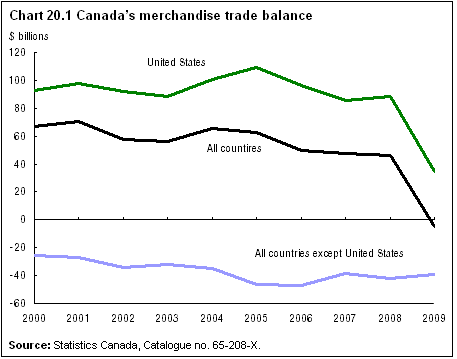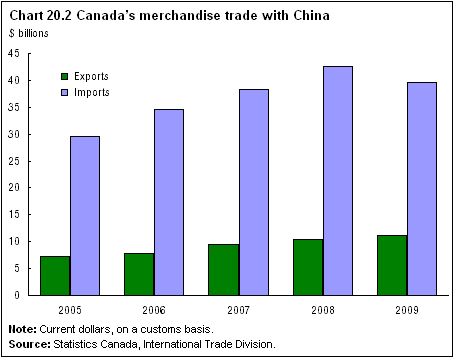International trade
Archived Content
Information identified as archived is provided for reference, research or recordkeeping purposes. It is not subject to the Government of Canada Web Standards and has not been altered or updated since it was archived. Please "contact us" to request a format other than those available.
Related information
Canada's international merchandise trade was significantly affected by the decline of the global economy in 2008 and 2009. The largest decreases in exports and imports occurred mostly in the first quarter of 2009.
Canada exported $369.5 billion worth of merchandise, a drop of 24.6% from 2008. There were declines in all export sectors, especially in energy products. Imports fell 15.7% to $374.1 billion.
As a result, the trade balance with the world swung from a surplus of $46.2 billion in 2008 to a deficit of $4.6 billion in 2009—the first trade deficit since 1975.
The trade surplus with the United States—Canada's largest trading partner—fell from $88.5 billion in 2008 to $34.9 billion in 2009, the lowest surplus since 1997. This was largely because of lower exports of crude petroleum, but also reflected the auto industry's difficulties.
Meanwhile, the trade deficit with countries other than the United States narrowed from $42.2 billion in 2008 to $39.5 billion in 2009.
Reliance on U.S. trade lessening
Driven by large decreases in exports of energy products and automotive products, Canada's reliance on the United States as a trading partner declined from 75% of total trade (the sum of exports plus imports) in 2005 to 68% in 2009.
For the first time, countries other than the United States accounted for more than 25% of Canada's exports, up from 18% in 2005. This rise occurred despite exports to these countries declining in 2009. Similarly, the share of Canada's imports from countries other than the United States rose from 33% in 2005 to 37% in 2009. This increase occurred even though imports from these countries fell for the first time in eight years.
Exports to the United States declined 26.7% in 2009 to $271.2 billion, led by falling prices of energy products and lower demand for automotive products. Imports fell 16.1% to $236.3 billion, also reflecting the weak auto sector.
Canada's exports to Europe declined 18.9% to $34.3 billion. The decrease was widespread across the continent; however, the United Kingdom, the Netherlands, Belgium, Germany and Norway accounted for almost 60% of the drop. Imports from Europe also declined to $57.0 billion, largely as a result of lower imports of crude oil from Norway and the United Kingdom to refineries in Eastern Canada.

View data source for chart 20.1
Trade contracted globally
According to the Organisation for Economic Co-operation and Development, all OECD countries experienced reductions in total trade, as did Brazil, India and China. Most experienced declines greater than 20%. The Russian Federation saw its total trade fall more than 35%.
The value of U.S. total trade fell more than 22% in 2009; however, the United States remained the top importing nation in the world.
China replaced Japan as the country with the third-largest export market in 2009, behind the United States and the United Kingdom. Exports to China, which have been growing since 2002, reached $11.2 billion in 2009, a 6.6% rise from 2008. Growth was fuelled by strong exports of canola, iron ores and coal. China is Canada's second-largest source of imports.
- Date modified:

